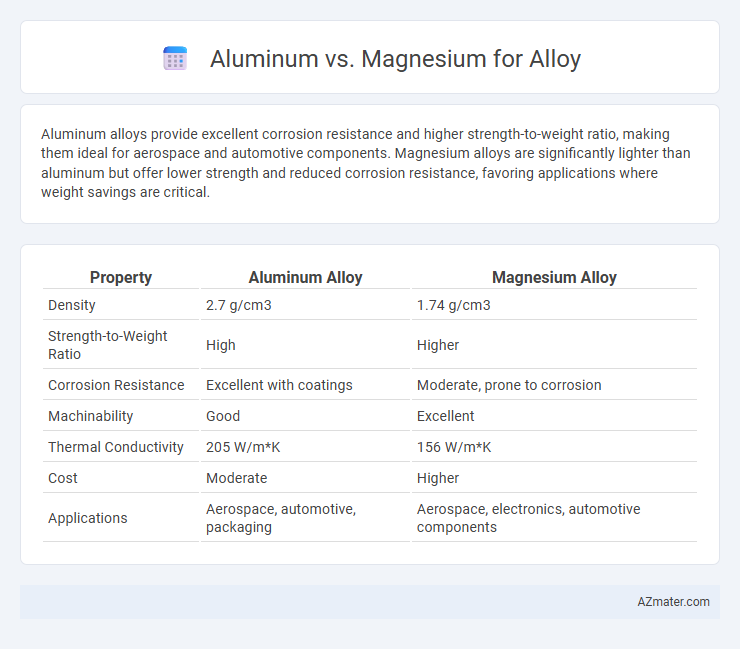Aluminum alloys provide excellent corrosion resistance and higher strength-to-weight ratio, making them ideal for aerospace and automotive components. Magnesium alloys are significantly lighter than aluminum but offer lower strength and reduced corrosion resistance, favoring applications where weight savings are critical.
Table of Comparison
| Property | Aluminum Alloy | Magnesium Alloy |
|---|---|---|
| Density | 2.7 g/cm3 | 1.74 g/cm3 |
| Strength-to-Weight Ratio | High | Higher |
| Corrosion Resistance | Excellent with coatings | Moderate, prone to corrosion |
| Machinability | Good | Excellent |
| Thermal Conductivity | 205 W/m*K | 156 W/m*K |
| Cost | Moderate | Higher |
| Applications | Aerospace, automotive, packaging | Aerospace, electronics, automotive components |
Introduction to Aluminum and Magnesium Alloys
Aluminum alloys are widely used in aerospace, automotive, and construction industries due to their excellent strength-to-weight ratio, corrosion resistance, and ease of fabrication. Magnesium alloys offer the lightest structural metal option, providing superior weight savings and good machinability but generally lower corrosion resistance and strength compared to aluminum alloys. Both metals are key in alloy form for improving mechanical properties, with aluminum alloys dominating in applications requiring durability and magnesium alloys preferred for ultra-lightweight components.
Chemical Composition and Properties
Aluminum alloys primarily consist of aluminum combined with elements such as copper, zinc, magnesium, and silicon, offering a balance of strength, corrosion resistance, and lightweight properties. Magnesium alloys contain a higher percentage of magnesium, often alloyed with aluminum, zinc, and manganese, providing superior strength-to-weight ratios and excellent machinability but lower corrosion resistance compared to aluminum alloys. The chemical composition directly influences properties like tensile strength, hardness, density, and thermal conductivity, with aluminum alloys favored for corrosion resistance and magnesium alloys chosen for applications requiring maximum weight reduction.
Mechanical Strength Comparison
Aluminum alloys typically exhibit higher tensile strength, ranging from 200 to 600 MPa, compared to magnesium alloys, which usually fall between 150 and 350 MPa. Magnesium alloys are valued for their superior strength-to-weight ratio and lower density of approximately 1.74 g/cm3 versus aluminum's 2.70 g/cm3, making magnesium advantageous where weight reduction is critical. Both materials demonstrate good corrosion resistance with appropriate treatments, but aluminum alloys generally provide better fatigue resistance and ductility in structural applications.
Corrosion Resistance Differences
Aluminum alloys exhibit superior corrosion resistance compared to magnesium alloys due to the formation of a stable aluminum oxide layer that protects the metal from further oxidation. Magnesium alloys are more prone to galvanic corrosion and rapid degradation, especially in saline or humid environments, because their protective oxide films are less robust and less adherent. The enhanced corrosion resistance of aluminum alloys makes them preferable for applications requiring long-term durability in harsh atmospheric and marine conditions.
Weight and Density Analysis
Magnesium alloys typically have a lower density of around 1.74 g/cm3 compared to aluminum alloys, which range from 2.6 to 2.8 g/cm3, making magnesium significantly lighter. This weight advantage translates to better strength-to-weight ratios in applications requiring high performance and reduced mass, such as aerospace and automotive industries. However, aluminum alloys often provide improved corrosion resistance and ease of manufacturing, balancing the trade-offs between weight and material properties.
Thermal and Electrical Conductivity
Aluminum alloys exhibit higher thermal conductivity, typically around 235 W/m*K, compared to magnesium alloys, which range near 160 W/m*K, making aluminum preferable for heat dissipation applications. In terms of electrical conductivity, aluminum outperforms magnesium significantly with conductivity approximately 35-38 MS/m versus magnesium's lower conductivity of about 6-7 MS/m. The enhanced thermal and electrical properties of aluminum alloys facilitate their use in electronics and automotive components requiring efficient heat transfer and electrical conduction.
Machinability and Workability
Magnesium alloys offer superior machinability compared to aluminum alloys due to their lower density and softer metal matrix, which reduces tool wear and cutting forces during manufacturing processes. Aluminum alloys exhibit better workability, providing greater ductility and formability that enable complex shaping and bending without cracking. Choosing between aluminum and magnesium alloys depends on the specific machining requirements and the desired balance between lightweight properties and ease of fabrication.
Cost and Availability Factors
Aluminum alloys generally offer lower cost and greater availability compared to magnesium alloys due to abundant global reserves and well-established production infrastructure. Magnesium, while lighter and offering superior strength-to-weight ratio, remains more expensive because of limited extraction sources and complex processing methods. Cost-efficiency in manufacturing and widespread industrial usage make aluminum the preferred choice for alloy applications where budget and accessibility are critical.
Common Applications in Industries
Aluminum alloys dominate aerospace, automotive, and packaging industries due to their corrosion resistance, lightweight, and high strength-to-weight ratio. Magnesium alloys are favored in electronics, automotive, and aerospace sectors where exceptional lightweight properties and vibration damping are essential. Both metals enhance fuel efficiency, structural integrity, and overall performance across industrial applications.
Environmental Impact and Sustainability
Magnesium alloys offer a lower environmental impact compared to aluminum due to their lighter weight, which translates to reduced fuel consumption and greenhouse gas emissions in transportation applications. Aluminum production is energy-intensive, contributing to higher carbon footprints, but its recyclability significantly improves sustainability by saving up to 95% of the energy required for primary aluminum production. Choosing magnesium or aluminum alloys depends on balancing factors like recyclability, energy use in manufacturing, and the environmental benefits gained through material efficiency in end-use products.

Infographic: Aluminum vs Magnesium for Alloy
 azmater.com
azmater.com